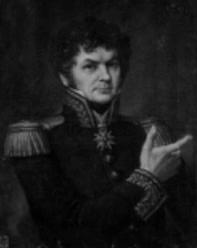General Joseph Boyer de Rébéval

Born: April 20, 1768
Place of Birth: Vaucouleurs, Meuse, France
Died: March 5, 1822
Place of Death: Paris, France
Pronunciation:
Joining the artillery regiment of Auxonne in 1787, Joseph Boyer was later commissioned as a sous-lieutenant in the infantry at the end of 1791. In 1792 he was promoted to lieutenant and he served with the Army of the Alps and then in 1794 he joined the Army of the Sambre and Meuse. In 1797 Boyer joined the Army of Italy as part of Bernadotte's force sent to reinforce that army and that March he fought at the crossing of the Tagliamento where he was wounded by a shot to the right leg. A week later he was promoted to capitaine. In 1799 Boyer served with the Army of the Danube and he was promoted to chef de bataillon. Next he served with the Army of Italy before joining the Army of the Reserve in 1800 as an aide-de-camp to General Duhesme. Serving on the campaign in Italy, Boyer distinguished himself at the crossing of the Tessin at the end of May and then in June he served at the actions of Lodi and Cremona and the crossing of the Adda. When war briefly resumed that winter, he fought at the crossing of the Mincio in December where his left thigh was wounded by a ball.
During the peace that followed, Boyer served in garrison in France. In 1803 he joined the Army of the Coasts of the Ocean and then in 1805 he joined the Imperial Guard as a chef de bataillon in the Chasseurs à Pied. Boyer took part in the campaign against the Third Coalition that year and then in 1806 he was appointed major in the Velites of the Guard. He served at the Battle of Jena in October and later he was assigned to General Teulié's division. In February of 1807 Boyer took the fort of Neugarten and then in March he was appointed major-colonel of the Fusiliers-Chasseurs of the Imperial Guard. His next major action came in June when he served at the Battle of Friedland.
In 1808 Boyer was appointed colonel-major of the 2nd Chasseurs à Pied of the Imperial Guard and he served in Spain. In 1809 he became Baron of Rébéval and he served in the Army of Germany. That June Boyer de Rébéval was promoted to général de brigade and he took command of the 2nd Brigade of Gudin's division in Marshal Davout's III Corps. He led his men into action at the Battle of Wagram in July and then in September he was named a Commander of the Legion of Honor. At the end of 1811 Boyer de Rébéval returned to the Imperial Guard and in 1812 he was named commander of the Chasseurs à Pied of the Old Guard in Curial's division. He took part in the campaign against Russia and he fought at the Battle of Borodino where he was wounded by a shot to the right wrist.
Having survived the retreat from Russia, in June of 1813 Boyer de Rébéval took command of the 1st Brigade of Roguet's 4th Division of the Young Guard. He served on the campaign in Saxony and he fought at the Battle of Dresden that August where he was wounded by a shot to the stomach. In November Boyer de Rébéval was promoted to général de division and then in December he took command of the 3rd Division of the Young Guard. For the defense of France of 1814 he initially served at Lille and then in February he took command of a newly formed division of the Young Guard at Paris. Sent to the front with his division, Boyer de Rébéval and his men were placed under Marshal Victor's command. Boyer de Rébéval distinguished himself in the fighting at Méry-sur-Seine on February 22nd and then he saw frequent action in March, fighting at Craonne where he was wounded by a ball to the left thigh and then serving at Laon and Reims before his division was dissolved. Nevertheless, he went on to assist at the action of Châlons-sur-Marne. At the end of the month, Boyer de Rébéval took command of a division formed at Paris under Marshal Marmont and he took part in the defense of Paris.
After Napoleon's abdication and the Bourbon Restoration, Boyer de Rébéval was named commander of the department of Aube. During the Hundred Days of 1815 when Napoleon resumed power, Boyer de Rébéval was initially given command of an infantry division at Poitiers. He later served in the Army of the Loire and then in October he was put on non-activity.
Bibliography
Related Pages:
Updated March 2025
© Nathan D. Jensen